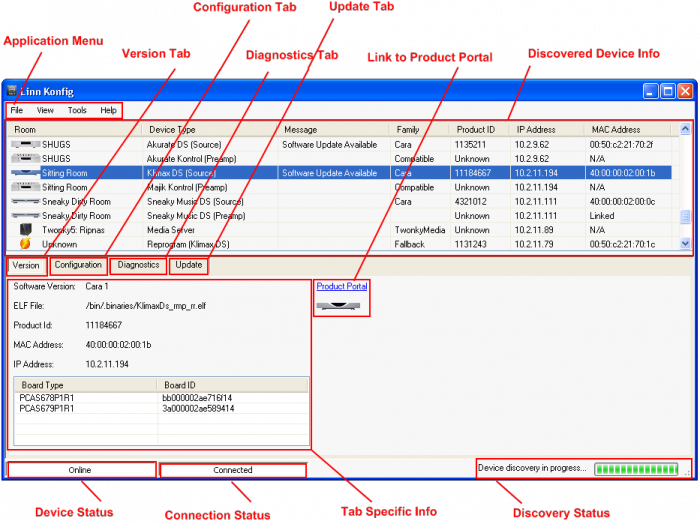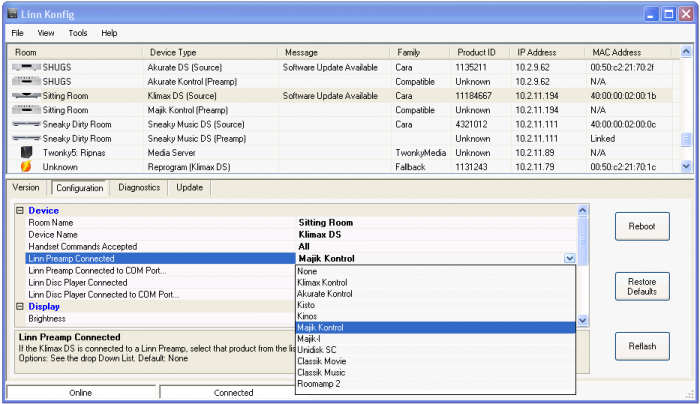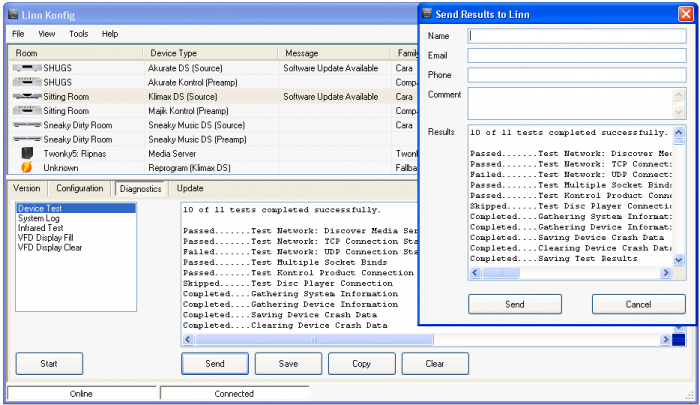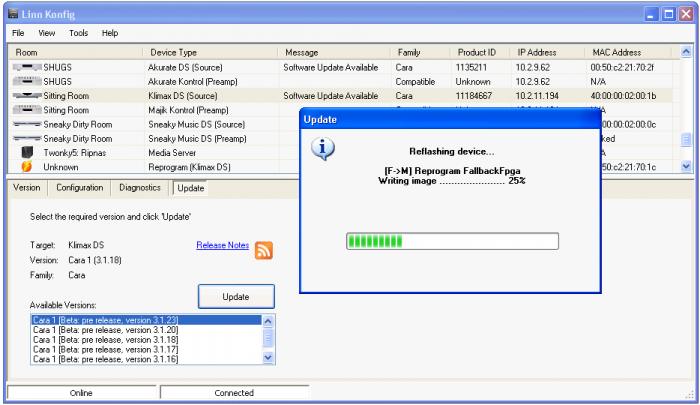Difference between revisions of "Linn Konfig Manual"
(→Diagnostics) |
|||
| Line 44: | Line 44: | ||
=== Diagnostics === | === Diagnostics === | ||
[[Image:KonfigDiagnostics.PNG|700px|Diagnostics]] | [[Image:KonfigDiagnostics.PNG|700px|Diagnostics]] | ||
| + | * Select the test you wish to run and click the start button | ||
| + | ** Device test: runs the standard diagnostics tests for your device | ||
| + | ** System log: displays the active device log | ||
| + | ** Infrared test: will display all IR commands sent to your device (where applicable) | ||
| + | ** VFD Display Fill: turn all pixels on (where applicable) | ||
| + | ** VFD Display Clear: turn all pixels off (where applicable) | ||
| + | ** Locate device: triggers blinking search led (where applicable) | ||
| + | * Once the test is complete, you can copy, save, clear, or send the data to Linn | ||
| + | ** Sending the data to Linn will bring up a form where you can optionally supply your own details if you wish to be contacted | ||
| + | ** Sending your data to Linn will also send any crash data your device may contain, as well as relevant system information and the debug console data | ||
<br> | <br> | ||
| + | |||
=== Update === | === Update === | ||
[[Image:KonfigUpdate.PNG|700px|Update]] | [[Image:KonfigUpdate.PNG|700px|Update]] | ||
Revision as of 14:57, 28 July 2009
Contents
Introduction
Installation
To install Linn Konfig double-click on the latest Linn Konfig downloadable from the software download page. Follow the on screen installation instructions to complete the installation. Upon a successful installation, you can access Linn Konfig by tapping Start->Programs->Linn->Konfig.
Linn Konfig can be uninstalled using your platforms normal mechanisms for removing programs. An uninstaller program is distributed with the application if you want to uninstall it manually.
System Requirements
- OS: Windows XP/Vista with Microsoft .NET Framework v2.0, Linux with Mono v2.4, or Mac OS X with Mono v2.4
- RAM: 512MB
- Video Card: 800x600
Operation
Setup (Tools->Options)
- Network Tab: select the network adapter you are currently using
- Update Tab: enable or disable automatic update checks, as well as visibility of Beta or Development software (advanced users only)
Device Selection (Version)
- Devices will be discovered automatically when the application is loaded
- Discovery status shows discovery progress
- Discovered device info shows all relevant devices and their vital stats
- Select View->Refresh Device List (or press F5) if your device is missing from the list
- You can also toggle between Deatils, Icons, List, and Tree views from the View menu
- Click on a device in the list to display it's version information
- Click on the product portal link to display the device specific web page
- Click on the various tabs for device configuration, diagnostics, and update
- Device status (bottom left) will tell you if the device is Online, Offline, or Fallback (Reporgram) mode.
- Connection status (bottom left) will tell you if you are currently connected to the device
Configuration
- The configuation tab allows you to change all of the various settings for the selected device
- Drop down boxes are provided for settings that only allow certain values
- All other settings can be typed into the box provided
- Reboot: press this button to reboot your device (required after changing most settings for the settings to become active)
- Restore Defaults: use this button to restore your device to the all of its defualt (factory) settings
- Reflash (advanced users only): use this button to manually upload software to your device (requires this software to be downloaded and stored locally on your PC)
Diagnostics
- Select the test you wish to run and click the start button
- Device test: runs the standard diagnostics tests for your device
- System log: displays the active device log
- Infrared test: will display all IR commands sent to your device (where applicable)
- VFD Display Fill: turn all pixels on (where applicable)
- VFD Display Clear: turn all pixels off (where applicable)
- Locate device: triggers blinking search led (where applicable)
- Once the test is complete, you can copy, save, clear, or send the data to Linn
- Sending the data to Linn will bring up a form where you can optionally supply your own details if you wish to be contacted
- Sending your data to Linn will also send any crash data your device may contain, as well as relevant system information and the debug console data
Update
Troubleshooting
Debug Console
- Select Tools->Debug Console for deatiled debug information for your current session
Right Click Menu on Mac
- The right click menu available when clicking on a device in the list is not currently implemented in Mono v2.4 for Mac OS X. These operations can all be accessed through other means.



